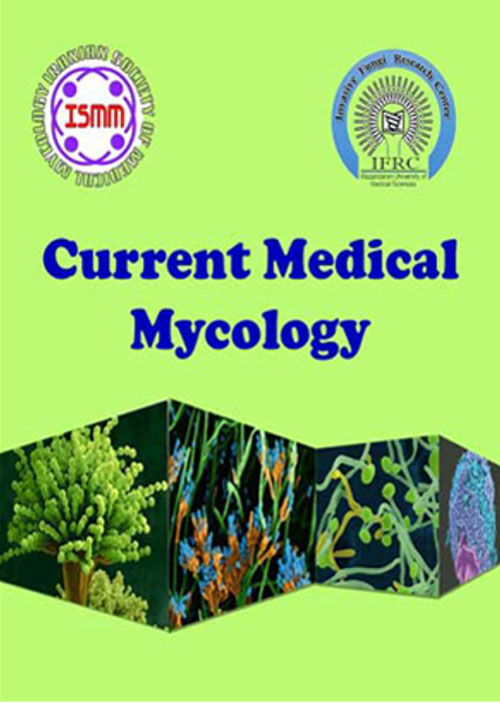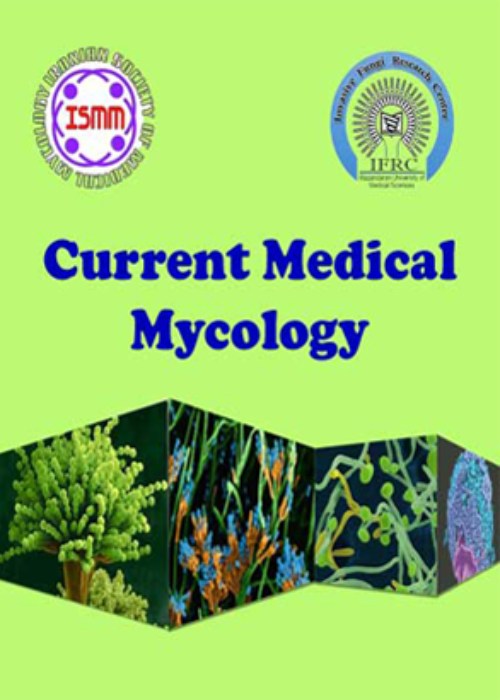فهرست مطالب

Current Medical Mycology
Volume:7 Issue: 2, Jun 2021
- تاریخ انتشار: 1400/08/17
- تعداد عناوین: 8
-
-
Pages 1-7Background and Purpose
The most common etiological agents of human dermatophytosis in various parts of the world are Trichophyton rubrum, Trichophyton interdigitale, and Epidermophyton floccosum. The main aim of this study was to design and evaluate a simple and straightforward multiplex polymerase chain reaction (PCR)assay for reliable identification/differentiation of these species in clinical isolates.
Materials and MethodsThe reliable sequences of several molecular targets of dermatophytes species were used to design a multiplex PCR for the identification of common pathogenic dermatophytes. The isolates and clinical specimens examined in this study included seven standard strains of dermatophytes, 101 isolates of dermatophytes and non-dermatophyte molds/yeasts which had already been identified by sequencing or PCR-restriction fragment length polymorphism (RFLP), and 155 clinical samples from patients suspected of cutaneous mycoses.
ResultsSpecies-specific primer pairs for T. rubrum and T. interdigitale/T. mentagrophytes were designed based on the sequence data of the translation elongation factor 1-alpha gene, and the primers for E. floccosum targeted the specific sequence of the internal transcribed spacer region (ITS). The multiplex PCR successfully detected T.rubrum, T. interdigitale/T. mentagrophytes, and E. floccosum strains that were identified by sequencing or PCR-RFLP. However, the primer pairs selected for T. interdigitale/T. mentagrophytes cross-reacted with Trichophyton tonsurans. In testing the PCR system directly for clinical samples, the proportion of positive multiplex PCR was higher than positive culture (68.1% vs. 55.4%, respectively).
ConclusionThe multiplex assay could detect three common agents out of several causal agents of dermatophytosis, namely T. rubrum, T. interdigitale, and E. floccosum.Therefore, by adding pan-dermatophyte primers it can be used as a comprehensive detection/identification test.
Keywords: E. floccosum, T. interdigitale, T. mentagrophytes, T. rubrum, Dermatophyte -
Pages 8-13Background and Purpose
The predominant cause of candidiasis was Candida albicans which has recently changed to non-Candida albicans Candida (NCAC) (i.e., Candida spp. other than the C. albicans). The NCAC spp., earlier considered non-pathogenic or minimally virulent, are now considered a primary cause of morbidity and mortality in immunocompromised individuals. Given the NCAC spp.has become more common in clinical cases, this study aimed to determine the prevalence of NCAC spp. in different clinical specimens and assess a few of their virulence factors.
Materials and MethodsRoutine samples for bacterial culture and sensitivity that showed colony characteristics, like Candida on Blood Agar and microscopic features resembling Candida spp., were processed further. Candida isolates underwent tests for chlamydospore formation and biochemical tests, including sugar fermentation and sugar assimilation tests. These were grown at 42oC, and their colony color was identified using HiCrome™ Candida Differential Agar (HiMedia Laboratories Pvt. Ltd., Mumbai,India), HiCandidaTM Identification Kit (HiMedia Laboratories Pvt. Ltd., Mumbai, India),and VITEK-2® Compact (Biomérieux, France). Virulence factors, such as adherence to buccal epithelial cells (ABEC), biofilm formation, hemolytic activity, and production of coagulase enzyme were also tested.
ResultsMean age of the patients was 38.46 years with a male-female ratio of 1.36:1. In total, 137 Candida isolates were recovered; 45.3%, 19.7%, and 13.9% of the isolates were isolated from urine, vaginal swabs, and oropharyngeal swabs, respectively. Moreover, 55(40.1%) isolates were those of C. albicans and 82 (59.9%) isolates belonged to NCAC spp.,with C. tropicalis (23.4%) contributing highest among NCAC species. Furthermore, C. albicans (3; 50%) was the most common spp. in cases of candidemia. Haemolysin production (85.5%) and ABEC (78.2%) were the major virulence factors in C. albicans. C.tropicalis (59.4%) and C. dubliniensis (50%) showed maximum ABEC. Biofilm forming capacity was higher in C. tropicalis (78.1%) than C. albicans (67%).
ConclusionResults of this study suggest varied prevalence and virulence based on geographical locations, even within a subcontinent. It clearly indicates the emergence of the NCAC spp. and their predominance in different body fluids. Identification of Candida to the spp. level should become a routine in all laboratories.
Keywords: ABEC, NCAC, Non-Candida albicans Candida species, VITEK-2® Compact -
Pages 14-21Background andPurposeBlack Cumin of Kerman (Bunium persicum) is an Iranian plant that is commonly used as an antispasmodic, carminative, and antimicrobial substance. The present study aimed to assess different components of the essence of B.persicum and its effect on antifungal activity, spore germination inhibition, and expressions of FUM1 and FUM14 genes in Fusarium verticillioides strains.Materials and MethodsThe essence was extracted by hydrodistillation and analyzed through gas chromatography-mass spectroscopy. A broth microdilution method was used for the determination of the minimum inhibitory concentration (MIC). In addition, the expression of FUM1 and FUM14 genes of toxigenic F. verticillioides was assessed byusing the real-time polymerase chain reaction (RT-PCR) technique.ResultsBased on the findings, most of the essence consisted of γ-terpinene (15.56%),propanal, and 2-methyl-3-phenyl (14.18%). The oil showed a good antifungal activity(mean MIC value: 2556.8 μg/ml) as well as the inhibition of spore germination and mycelial growth (P<0.05). The RT-PCR demonstrated that the expression levels of FUM1 and FUM14 of B. persicum-treated F. verticillioides were 0.43 and 0.53 folds ower than the control samples, respectively.ConclusionThese findings revealed that the essential oil of B. persicum has different components responsible for the inhibition of mycelial growth and spore germination of F. verticillioides as well as reduction of expressions of FUM1 and FUM14 genes involving fumonisin production.Keywords: Antifungal activity, Bunium Persicum, FUM1, FUM14 genes, Fusarium verticillioides, real time-PCR
-
Pages 22-28Background andPurposeThe main environmental saprobes, such as Penicillium, play an essential role in natural ecosystems as economically, ecologically, and medically important microorganisms. Biodiversity of this genus has not been described in Bushehr city, Iran. The present study is based on air biodiversity of Penicillium species on culture dependent approach and culture-independent technique using partial b-tubulin sequences.Materials and MethodsBy using active sampling with a high volume air sampler, a total of 157 Penicillium isolates were selected and screened for phenotypic characters. For the purposes of the study, 46 strains representative of 11 morphological species wereselected and identified by molecular analysis.ResultsBased on the findings, P. crustosum (18 isolates, 39.1%) and P. chrysogenum (15 isolates, 32.6%) were the most common isolated species, followed by P. brevicompactum, P. rubens, P. citrinum, P. italicum (each 2 isolates, 4.3%), P. olsonii, P. expansum, P. griseofulvum, P. palitans, and P. polonicum (each 1 isolate, 2.1%).Except for P. chrysogenum and P. expansum with floccose colony texture, the rest of the isolated species had velutinous texture.ConclusionThis is the first report in southern Iran to identify a large number of Penicillium strains isolated from air samples, showing P. crustosum and P. chrysogenum as the most common isolated species.Keywords: beta-tubulin, Bushehr, Penicillium
-
Pages 29-33Background and Purpose
Superficial mycoses are the fourth most common cause of disease worldwide. It is not surprising that zoonotic transmission occurs to humans due to close contact with different animals, be it companion or farm animals. Therefore, the objective of this study was to determine the presence of asymptomatic dermatophyte carriers in the owner-pet pairs, identify the most common etiologic agents, and find the likely connection between the carrier status of an owner and the presence of dermatophytes in their pets.
Materials and MethodsFrom May 2019 to January 2020, 21 cats and 115 dogs with their respective owners were selected for dermatophyte culture. All the dogs and cats included in the study were from the communities of southeastern Mexico. The samples were taken with a cotton swab, which was vigorously rubbed and twisted on the scalp or body of the pet four times and grown on Mycosel Agar. The isolates were identified based on macroscopic and microscopic characteristics. The prevalence of the binomial ranged from 0.73% in pet skin and human hands to 2.2% in human scalp. In humans, the agents were Trichophyton tonsurans and Trichophyton verrucosum, while in pets, astrain of Trichophyton sp was found.
ConclusionDifferent species of dermatophytes were found in the owner/pet pairs, which denotes that coexistence is not related in asymptomatic cases.
Keywords: México, Mycoses, PET, pet owners -
Pages 34-38Background and Purpose
The taxonomy of Candida is controversial and has undergone changes due to the investigation of the novel species. Candida africana and Candida dubliniensis are new members of C. albicans complex that are currently gaining both clinical and epidemiologic significance. This study reports the prevalence of C. africana among the strains isolated from patients, by using HWP1 gene size polymorphism.
Materials and MethodsA total of 235 yeasts confirmed as C. albicans complex based on chromogenic media and ITS-sequencing isolated from various clinical forms of invasive and non-invasive candidiasis mainly candidemia, were re-identified based on HWP1 gene polymorphisms. The Hwp1-PCR amplicons were re-confirmed by sequencing and BLAST analysis.
ResultsBased on the HWP1 gene size polymorphism, 223 strains were identified as C. albicans (94.89%) from which 7 isolates produced two DNA fragments (850 and 941 bp). C. dubliniensis (n=4, 1.7%), C. africana (n=1, 0.42%) and mix of C. albicans and C. africana (n=7, 2.97%) were also identified.
ConclusionAlthough C. albicans remains the most common Candida species, C. dubliniensis and C. africana are rarely found among the patient isolates. Due to limited information on the molecular epidemiology of this novel yeast, more studies using molecular methods are recommended.
Keywords: Candida albicans species complexes, Candida africana, Candida dubliniensis, HWP1 gene -
Pages 39-42Background and Purpose
Coronavirus disease 2019 (COVID-19) has become a significant clinical challenge in healthcare settings all over the world. Critically ill COVID-19 patients with acute respiratory distress syndrome may be at increased risk of co-infection with pulmonary aspergillosis. This study aimed to describe a clinical case of proven pulmonary aspergillosis caused by Aspergillus tubingensis in a 59-year-old man with a history of hospitalization due to COVID-19 infection.
Case reportThe Covid-19 infection was confirmed by positive nasopharyngeal polymerase chain reaction. He had a cavitary lesion measured 20 mm in diameter with intracavitary soft tissue density in the left lung in the first chest computerized tomography scan. After 25 days, he showed two cavitary lesions in both lungs which raised suspicion of fungal infection; hence, the patient underwent a trans-thoracic biopsy of the cavitary lesion. The direct examination and culture of the biopsy material revealed Aspergillus species. To confirm the Aspergillus species identification, the beta-tubulin region was sequenced. The patient was treated with oral voriconazole.
ConclusionThis report underlined the importance of early diagnosis and management of invasive fungal infections in severe COVID-19 patients
Keywords: Aspergillosis, Aspergillus tubingensis, COVID-19 -
Pages 43-47Background and Purpose
Coronavirus disease 2019 (COVID-19) and Candida prostatic valve endocarditis present various clinical manifestations which may overlap;hence, discrimination between them is extremely difficult.
Case reportThe case was a 66-year-old man with a past medical history of mitral and aortic valves replacement one year before COVID-19 co-infection. He was admitted with fever (for 7 days), shortness of breath, cough, seizure, lethargy,headache, and 85% oxygen saturation. Transesophageal echocardiography revealed multiple large-sized, highly mobile masses on both sides of the mechanical mitral valve highly suggestive of vegetation. Chest computed tomography scanning showed simulating scattered COVID-19 peripheral ground-glass opacities confirmed by reverse-transcription polymerase chain reaction. The set of blood cultures yieldedyeast colonies that were identified as Candida tropicalis. The patient died of septic shock shortly after receiving antifungal therapy.
ConclusionThis case emphasized the importance of early diagnosis andimplementation of antifungal treatment, particularly in patients with prosthetic cardiacvalves, to reduce their unfavorable outcomes in COVID-19 patients
Keywords: Candida endocarditis, case report, comorbidity, COVID-19, Prosthetic valve replacement, SARS-CoV-2, TRANSESOPHAGEAL ECHOCARDIOGRAPHY


